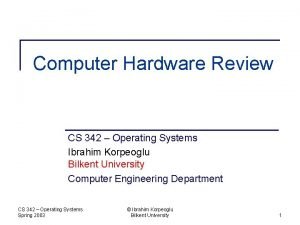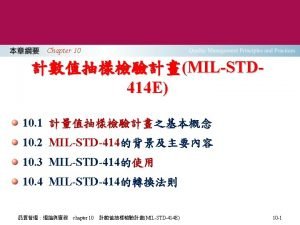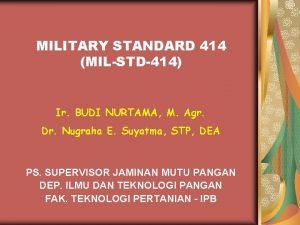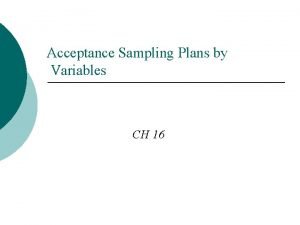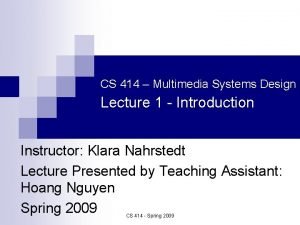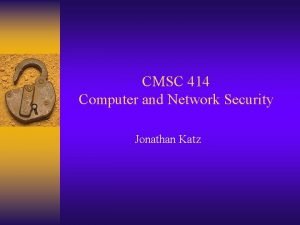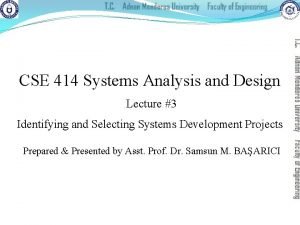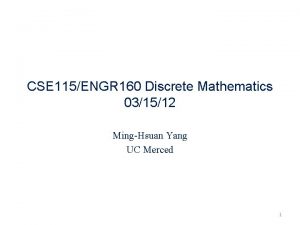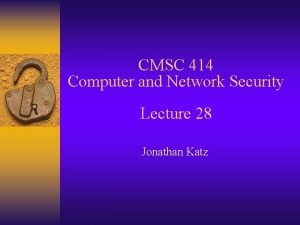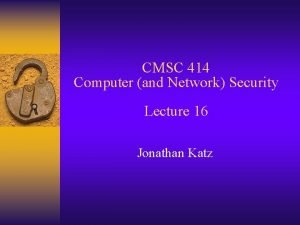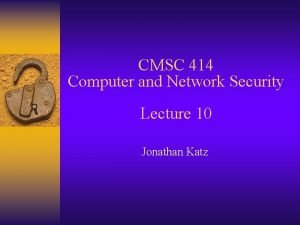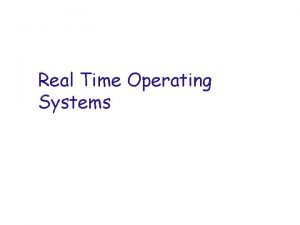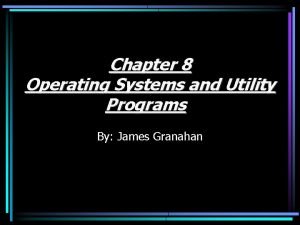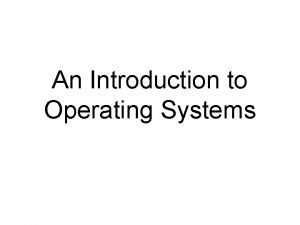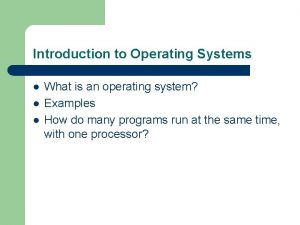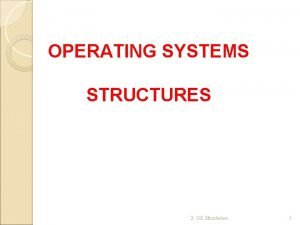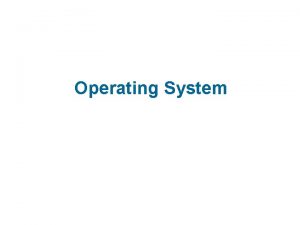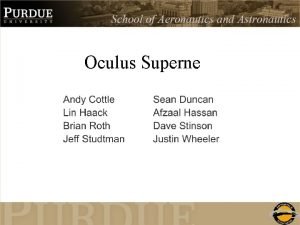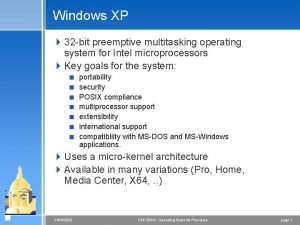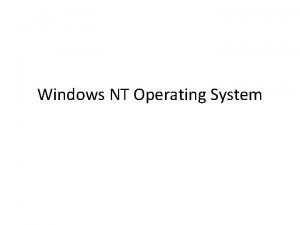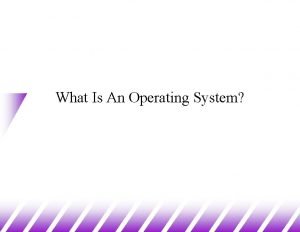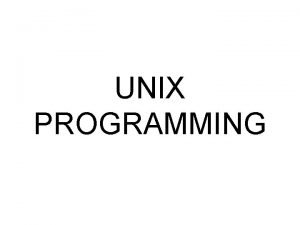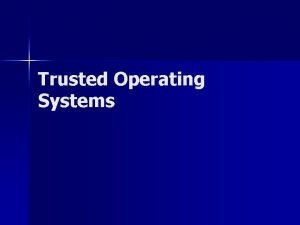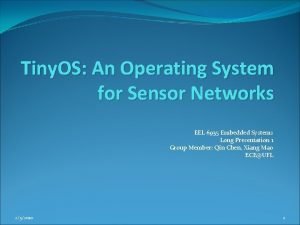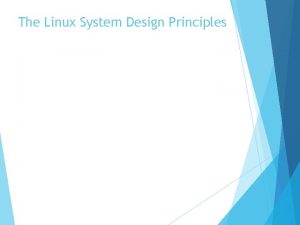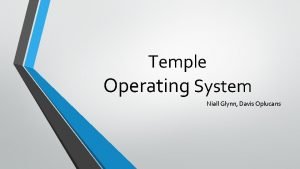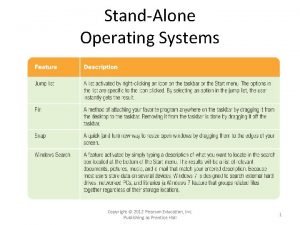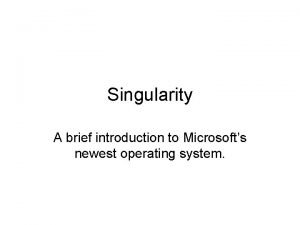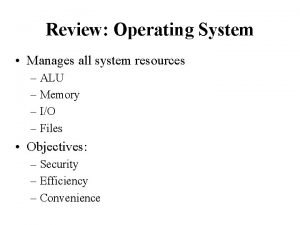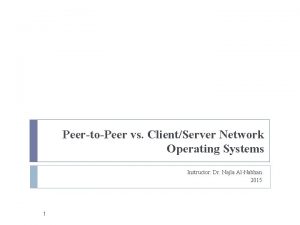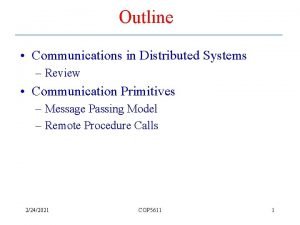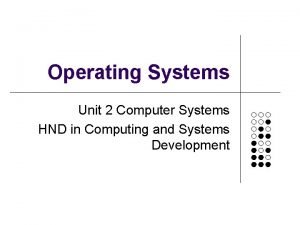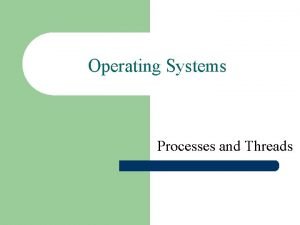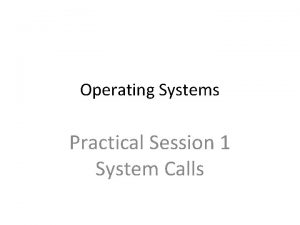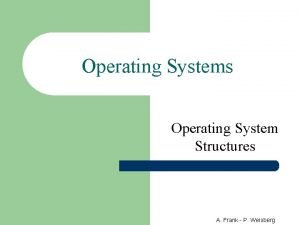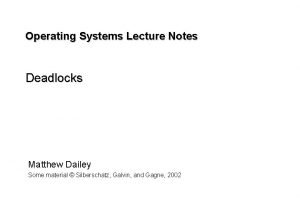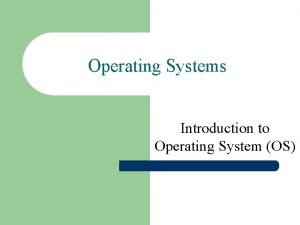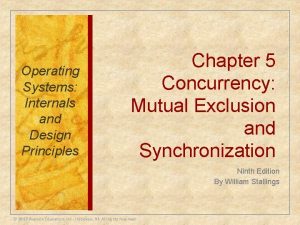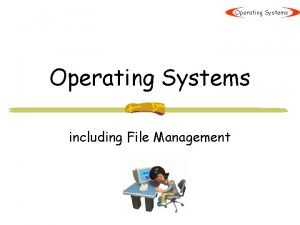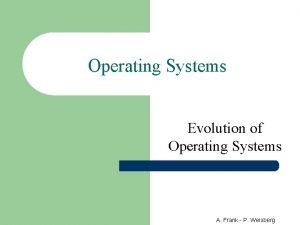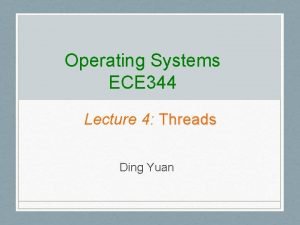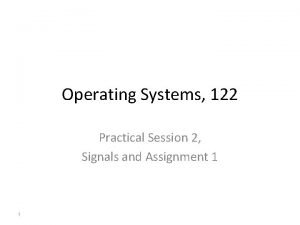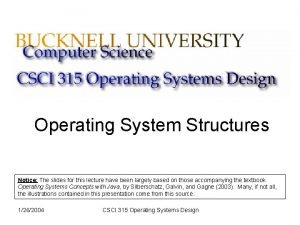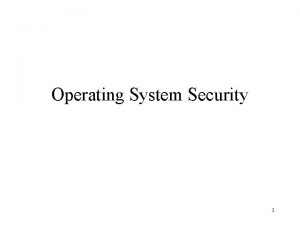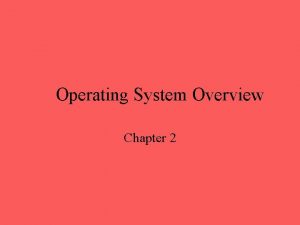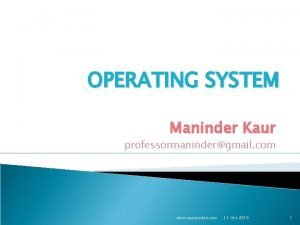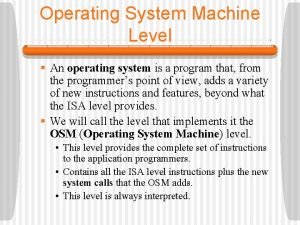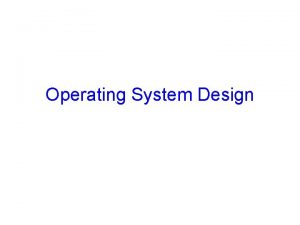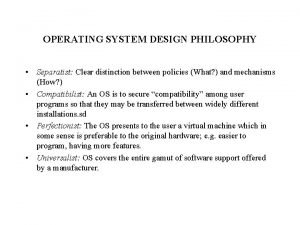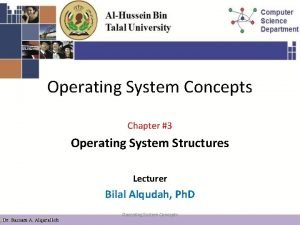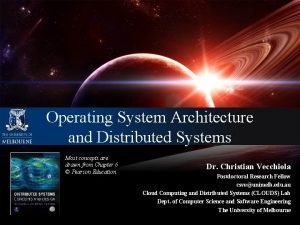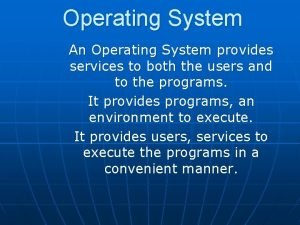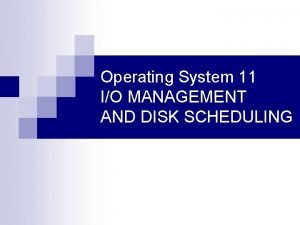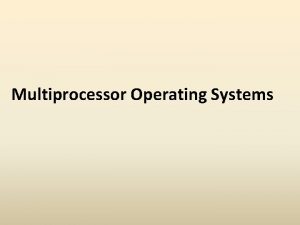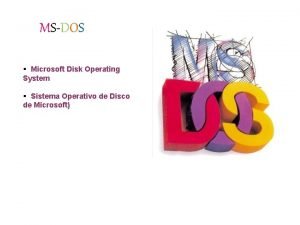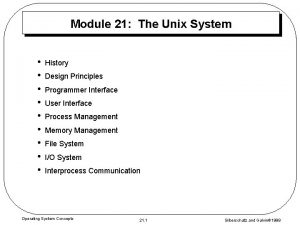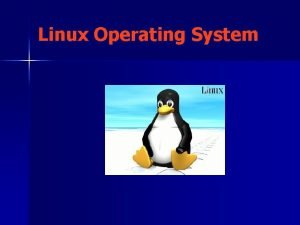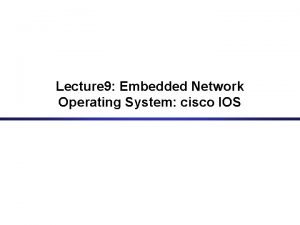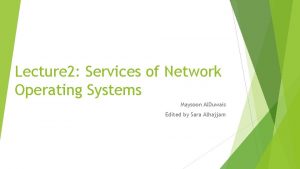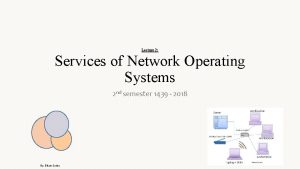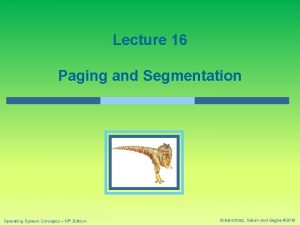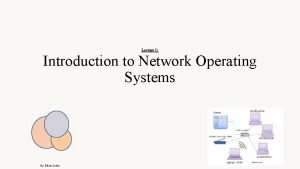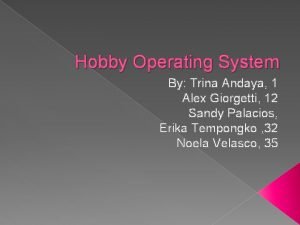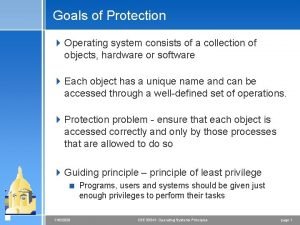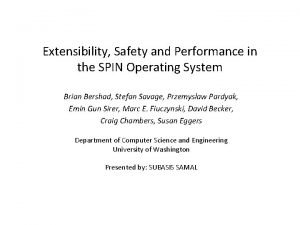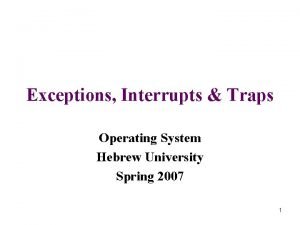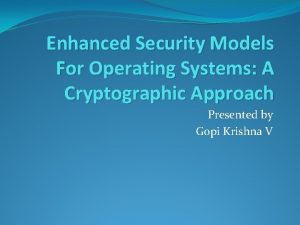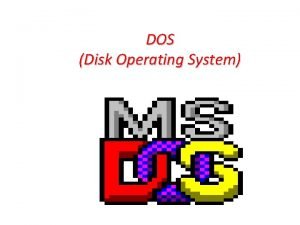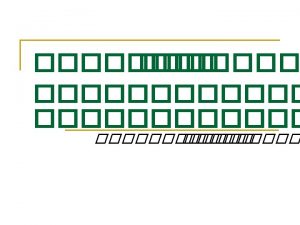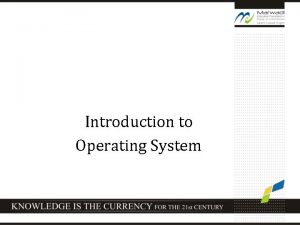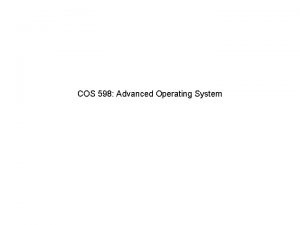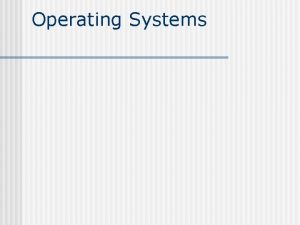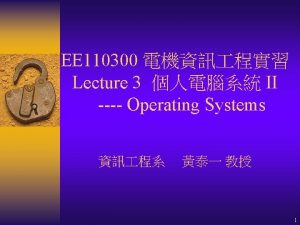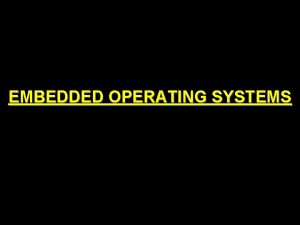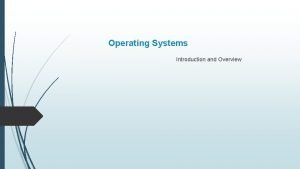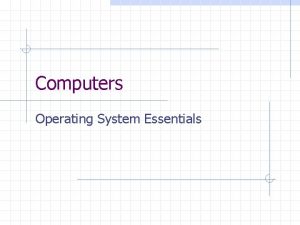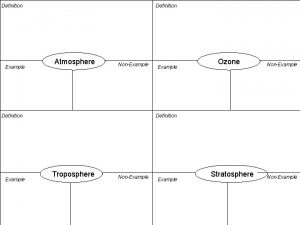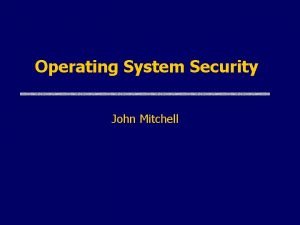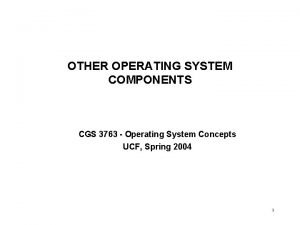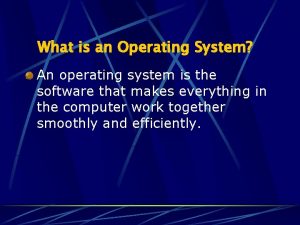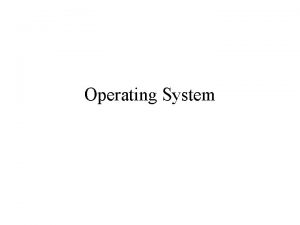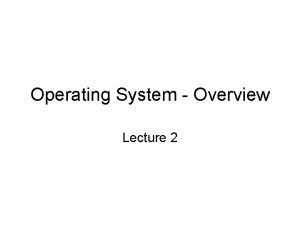CS 414 Review Operating System Definition An Operating


























![Basic Algorithm 1. If request[i] > need[i] then error (asked for too much) 2. Basic Algorithm 1. If request[i] > need[i] then error (asked for too much) 2.](https://slidetodoc.com/presentation_image_h/1c835f398df0f7fbec1b9a8731619b3c/image-27.jpg)







































































- Slides: 98

CS 414 Review

Operating System: Definition An Operating System (OS) provides a virtual machine on top of the real hardware, whose interface is more convenient than the raw hardware interface. Applications OS interface Operating System Hardware Physical machine interface Advantages Easy to use, simpler to code, more reliable, more secure, … 2 You can say: “I want to write XYZ into file ABC”

What is in an OS? Applications Quake System Utils Sql Server Shells Windowing & graphics OS Interface Operating System Services Naming Windowing & Gfx Networking Virtual Memory Generic I/O File System Device Drivers Access Control Process Management Memory Management Physical m/c Intf Interrupts, Cache, Physical Memory, TLB, Hardware Devices Logical OS Structure 3

Crossing Protection Boundaries • User calls OS procedure for “privileged” operations • Calling a kernel mode service from user mode program: – Using System Calls – System Calls switches execution to kernel mode User process System Call Trap Mode bit = 0 Save Caller’s state User Mode bit = 1 Resume process Kernel Mode bit = 0 Return Mode bit = 1 Execute system call Restore state 4

What is a process? • The unit of execution • The unit of scheduling • Thread of execution + address space • Is a program in execution – Sequential, instruction-at-a-time execution of a program. The same as “job” or “task” or “sequential process” 5

Process State Transitions interrupt itte d dispatch Exit ev en t t en ev on or leti I/O omp c wa it Running Waiting or Ready e don I/O New adm Processes hop across states as a result of: • Actions they perform, e. g. system calls • Actions performed by OS, e. g. rescheduling • External actions, e. g. I/O 6

Context Switch • For a running process – All registers are loaded in CPU and modified • E. g. Program Counter, Stack Pointer, General Purpose Registers • When process relinquishes the CPU, the OS – Saves register values to the PCB of that process • To execute another process, the OS – Loads register values from PCB of that process Context Switch - Process of switching CPU from one process to another - Very machine dependent for types of registers 7

Threads and Processes • Most operating systems therefore support two entities: – the process, • which defines the address space and general process attributes – the thread, • which defines a sequential execution stream within a process • A thread is bound to a single process. – For each process, however, there may be many threads. • Threads are the unit of scheduling • Processes are containers in which threads execute 8

Schedulers • Process migrates among several queues – Device queue, job queue, ready queue • Scheduler selects a process to run from these queues • Long-term scheduler: – load a job in memory – Runs infrequently • Short-term scheduler: – Select ready process to run on CPU – Should be fast • Middle-term scheduler – Reduce multiprogramming or memory consumption 9

CPU Scheduling • • FCFS LIFO SJF SRTF Priority Scheduling Round Robin Multi-level Queue Multi-level Feedback Queue 10

Race conditions • Definition: timing dependent error involving shared state – Whether it happens depends on how threads scheduled • Hard to detect: – All possible schedules have to be safe • Number of possible schedule permutations is huge • Some bad schedules? Some that will work sometimes? – they are intermittent • Timing dependent = small changes can hide bug

The Fundamental Issue: Atomicity • Our atomic operation is not done atomically by machine – Atomic Unit: instruction sequence guaranteed to execute indivisibly – Also called “critical section” (CS) When 2 processes want to execute their Critical Section, – One process finishes its CS before other is allowed to enter 12

Critical Section Problem • Problem: Design a protocol for processes to cooperate, such that only one process is in its critical section – How to make multiple instructions seem like one? Process 1 CS 1 Process 2 CS 2 Time Processes progress with non-zero speed, no assumption on clock speed Used extensively in operating systems: Queues, shared variables, interrupt handlers, etc. 13

Solution Structure Shared vars: Initialization: Process: . . . Entry Section Critical Section Added to solve the CS problem Exit Section 14

Solution Requirements • Mutual Exclusion – Only one process can be in the critical section at any time • Progress – Decision on who enters CS cannot be indefinitely postponed • No deadlock • Bounded Waiting – Bound on #times others can enter CS, while I am waiting • No livelock • Also efficient (no extra resources), fair, simple, … 15

Semaphores • Non-negative integer with atomic increment and decrement • Integer ‘S’ that (besides init) can only be modified by: – P(S) or S. wait(): decrement or block if already 0 – V(S) or S. signal(): increment and wake up process if any • These operations are atomic semaphore S; P(S) { while(S ≤ 0) ; S--; } V(S) { S++; } 16

Semaphore Types • Counting Semaphores: – Any integer – Used for synchronization • Binary Semaphores – Value 0 or 1 – Used for mutual exclusion (mutex) Process i Shared: semaphore S P(S); Init: S = 1; Critical Section V(S); 17

Mutexes and Synchronization semaphore S; Init: S = 1; 0; P(S) { while(S ≤ 0) ; S--; } Process i Process j V(S) { S++; } P(S); Code XYZ Code ABC V(S); 18

Monitors • Hoare 1974 • Abstract Data Type for handling/defining shared resources • Comprises: – Shared Private Data • The resource • Cannot be accessed from outside – Procedures that operate on the data • Gateway to the resource • Can only act on data local to the monitor – Synchronization primitives • Among threads that access the procedures 19

Synchronization Using Monitors • Defines Condition Variables: – condition x; – Provides a mechanism to wait for events • Resources available, any writers • 3 atomic operations on Condition Variables – x. wait(): release monitor lock, sleep until woken up condition variables have waiting queues too – x. notify(): wake one process waiting on condition (if there is one) • No history associated with signal – x. broadcast(): wake all processes waiting on condition • Useful for resource manager • Condition variables are not Boolean – If(x) then { } does not make sense 20

Types of Monitors What happens on notify(): • Hoare: signaler immediately gives lock to waiter (theory) – Condition definitely holds when waiter returns – Easy to reason about the program • Mesa: signaler keeps lock and processor (practice) – Condition might not hold when waiter returns – Fewer context switches, easy to support broadcast • Brinch Hansen: signaler must immediately exit monitor – So, notify should be last statement of monitor procedure 21

Deadlocks Definition: Deadlock exists among a set of processes if – Every process is waiting for an event – This event can be caused only by another process in the set • Event is the acquire of release of another resource One-lane bridge 22

Four Conditions for Deadlock • Coffman et. al. 1971 • Necessary conditions for deadlock to exist: – Mutual Exclusion • At least one resource must be held is in non-sharable mode – Hold and wait • There exists a process holding a resource, and waiting for another – No preemption • Resources cannot be preempted – Circular wait • There exists a set of processes {P 1, P 2, … PN}, such that – P 1 is waiting for P 2, P 2 for P 3, …. and PN for P 1 All four conditions must hold for deadlock to occur 23

Dealing with Deadlocks • Proactive Approaches: – Deadlock Prevention • Negate one of 4 necessary conditions • Prevent deadlock from occurring – Deadlock Avoidance • Carefully allocate resources based on future knowledge • Deadlocks are prevented • Reactive Approach: – Deadlock detection and recovery • Let deadlock happen, then detect and recover from it • Ignore the problem – Pretend deadlocks will never occur – Ostrich approach 24

Safe State • A state is said to be safe, if it has a process sequence {P 1, P 2, …, Pn}, such that for each Pi, the resources that Pi can still request can be satisfied by the currently available resources plus the resources held by all Pj, where j < i • State is safe because OS can definitely avoid deadlock – by blocking any new requests until safe order is executed • This avoids circular wait condition – Process waits until safe state is guaranteed 25

Banker’s Algorithm • Decides whether to grant a resource request. • Data structures: n: integer m: integer available[1. . m] max[1. . n, 1. . m] allocation[1. . n, 1. . m] need[1. . n, 1. . m] # of processes # of resources available[i] is # of avail resources of type i max demand of each Pi for each Ri current allocation of resource Rj to Pi max # resource Rj that Pi may still request let request[i] be vector of # of resource Rj Process Pi wants 26
![Basic Algorithm 1 If requesti needi then error asked for too much 2 Basic Algorithm 1. If request[i] > need[i] then error (asked for too much) 2.](https://slidetodoc.com/presentation_image_h/1c835f398df0f7fbec1b9a8731619b3c/image-27.jpg)
Basic Algorithm 1. If request[i] > need[i] then error (asked for too much) 2. If request[i] > available[i] then wait (can’t supply it now) 3. Resources are available to satisfy the request Let’s assume that we satisfy the request. Then we would have: available = available - request[i] allocation[i] = allocation [i] + request[i] need[i] = need [i] - request [i] Now, check if this would leave us in a safe state: if yes, grant the request, if no, then leave the state as is and cause process to wait. 27

Network Stack: Layering Node A Application Presentation Transport Network Data Link Physical Network Node B 28

End-to-End Argument • What function to implement in each layer? • Saltzer, Reed, Clarke 1984 – A function can be correctly and completely implemented only with the knowledge and help of applications standing at the communication endpoints – Argues for moving function upward in a layered architecture • Should the network guarantee packet delivery ? – Think about a file transfer program – Read file from disk, send it, the receiver reads packets and writes them to the disk 29

Packet vs. Circuit Switching • Reliability: no congestion, in-order data in circuit-switch • Packet switching: better bandwidth use • State, resources: packet switching has less state – Good: less control plane processing resources along the way – More data plane (address lookup) processing • Failure modes (routers/links down) – Packet switch reconfigures sub-second timescale – Circuit switching: more complicated • Involves all switches in the path 30

Link level Issues • • Encoding: map bits to analog signals Framing: Group bits into frames (packets) Arbitration: multiple senders, one resource Addressing: multiple receivers, one wire 31

Repeaters and Bridges • Both connect LAN segments • Usually do not originate data • Repeaters (Hubs): physical layer devices – forward packets on all LAN segments – Useful for increasing range – Increases contention • Bridges: link layer devices – Forward packets only if meant on that segment – Isolates congestion – More expensive 32

Network Layer Two important functions: • routing: determine path from source to dest. • forwarding: move packets from router’s input to output T 1 T 3 Sts-1 T 3 T 1 33

Two connection models • Connectionless (or “datagram”): – each packet contains enough information that routers can decide how to get it to its final destination b A b • Connection-oriented (or “virtual circuit”) B C – first set up a connection between two nodes – label it (called a virtual circuit identifier (VCI)) – all packets carry label A 1 1 1 B C 34

DNS name servers How could we provide this service? Why not centralize DNS? r single point of failure r traffic volume Name server: process running on a host that processes DNS requests local name servers: m r distant centralized database r maintenance doesn’t scale! m authoritative name server: m r no server has all name-to-IP address mappings each ISP, company has local (default) name server host DNS query first goes to local name server can perform name/address translation for a specific domain or zone 35

Purpose of Transport layer • Interface end-to-end applications and protocols – Turn best-effort IP into a usable interface • Data transfer b/w processes: – Compared to end-to-end IP network data link physical nd -e nd le ca gi – TCP – UDP network data link physical lo • We will look at 2: application transport network data link physical po s an tr network data link physical rt application transport network data link physical 36

UDP • Unreliable Datagram Protocol • Best effort data delivery between processes – No frills, bare bones transport protocol – Packet may be lost, out of order • Connectionless protocol: – No handshaking between sender and receiver – Each UDP datagram handled independently 37

UDP Functionality • Multiplexing/Demultiplexing – Using ports • Checksums (optional) – Check for corruption application-layer data segment header segment Ht M Hn segment P 1 M application transport network P 3 M M P 4 application transport network receiver M P 2 application transport network 38

TCP • Transmission Control Protocol – Reliable, in-order, process-to-process, two-way byte stream • Different from UDP – Connection-oriented – Error recovery: Packet loss, duplication, corruption, reordering • A number of applications require this guarantee – Web browsers use TCP 39

TCP Summary • Reliable ordered message delivery – Connection oriented, 3 -way handshake • Transmission window for better throughput – Timeouts based on link parameters • Congestion control – Linear increase, exponential backoff • Fast adaptation – Exponential increase in the initial phase 40

Remote Procedure Call • The basic model for Remote Procedure Call (RPC) was described by Birrell and Nelson in 1980, based on work done at Xerox PARC. • Goal to make RPC as much like local PC as possible. • Used computer/language support. • There are 3 components on each side: – a user program (client or server) – a set of stub procedures – RPC runtime support 41

Memory Management Issues • Protection: Errors in process should not affect others • Transparency: Should run despite memory size/location gcc Load Store CPU Translation box (MMU) virtual address Physical legal addr? address Physical memory Illegal? fault data How to do this mapping? 42

Scheme 1: Load-time Linking • Link as usual, but keep list of references • At load time: determine the new base address – Accordingly adjust all references (addition) static a. out 0 x 3000 jump 0 x 2000 OS 0 x 6000 jump 0 x 5000 0 x 1000 0 x 4000 • Issues: handling multiple segments, moving in memory 43

Scheme 2: Execution-time Linking • Use hardware (base + limit reg) to solve the problem – Done for every memory access – Relocation: physical address = logical (virtual) address + base – Protection: is virtual address < limit? OS a. out 0 x 3000 MMU Base: 0 x 3000 Limit: 0 x 2000 jump 0 x 2000 0 x 1000 a. out jump 0 x 2000 0 x 6000 0 x 4000 – When process runs, base register = 0 x 3000, bounds register = 0 x 2000. Jump addr = 0 x 2000 + 0 x 3000 = 0 x 5000 44

Segmentation • Processes have multiple base + limit registers • Processes address space has multiple segments – Each segment has its own base + limit registers – Add protection bits to every segment Real memory 0 x 1000 0 x 3000 0 x 5000 gcc 0 x 2000 Text seg r/o Stack seg r/w 0 x 6000 Base&Limit? How to do the mapping? 0 x 8000 0 x 6000 45

Mapping Segments • Segment Table – An entry for each segment – Is a tuple <base, limit, protection> • Each memory reference indicates segment and offset fault Virtual addr no mem yes ? 0 x 1000 3 128 + Seg# offset Seg table Prot base r len 0 x 1000 512 seg 128 46

Fragmentation • “The inability to use free memory” • External Fragmentation: – Variable sized pieces many small holes over time • Internal Fragmentation: – Fixed sized pieces internal waste if entire piece is not used Word ? ? gcc External fragmentation emacs allocated stack doom Unused (“internal 47 fragmentation”)

Paging • Divide memory into fixed size pieces – Called “frames” or “pages” • Pros: easy, no external fragmentation Pages typical: 4 k-8 k gcc emacs internal frag 48

Mapping Pages • If 2 m virtual address space, 2 n page size (m - n) bits to denote page number, n for offset within page Translation done using a Page Table Virtual addr 3 VPN ((1<<12)|128) 128 (12 bits) page offsetpage table ? “invalid” Prot VPN r 3 PPN 1 mem 0 x 1000 seg 128 PPN 49

Paging + Segmentation • Paged segmentation – Handles very long segments – The segments are paged • Segmented Paging – When the page table is very big – Segment the page table – Let’s consider System 370 (24 -bit address space) Seg # (4 bits) page # (8 bits) page offset (12 bits) 50

What is virtual memory? • Each process has illusion of large address space – 232 for 32 -bit addressing • However, physical memory is much smaller • How do we give this illusion to multiple processes? – Virtual Memory: some addresses reside in disk page table disk Physical memory 51

Virtual Memory • Load entire process in memory (swapping), run it, exit – Is slow (for big processes) – Wasteful (might not require everything) • Solutions: partial residency – Paging: only bring in pages, not all pages of process – Demand paging: bring only pages that are required • Where to fetch page from? – Have a contiguous space in disk: swap file (pagefile. sys) 52

Page Faults • On a page fault: – OS finds a free frame, or evicts one from memory (which one? ) • Want knowledge of the future? – Issues disk request to fetch data for page (what to fetch? ) • Just the requested page, or more? – Block current process, context switch to new process (how? ) • Process might be executing an instruction – When disk completes, set present bit to 1, and current process in ready queue 53

Page Replacement Algorithms • Random: Pick any page to eject at random – Used mainly for comparison • FIFO: The page brought in earliest is evicted – Ignores usage – Suffers from “Belady’s Anomaly” • Fault rate could increase on increasing number of pages • E. g. 0 1 2 3 0 1 4 0 1 2 3 4 with frame sizes 3 and 4 • OPT: Belady’s algorithm – Select page not used for longest time • LRU: Evict page that hasn’t been used the longest – Past could be a good predictor of the future 54

Thrashing • Processes in system require more memory than is there – Keep throwing out page that will be referenced soon – So, they keep accessing memory that is not there • Why does it occur? – No good reuse, past != future – There is reuse, but process does not fit – Too many processes in the system 55

Approach 1: Working Set • Peter Denning, 1968 – Defines the locality of a program pages referenced by process in last T seconds of execution considered to comprise its working set T: the working set parameter • Uses: – Caching: size of cache is size of WS – Scheduling: schedule process only if WS in memory – Page replacement: replace non-WS pages 56

Working Sets • The working set size is num pages in the working set – the number of pages touched in the interval (t, t-Δ). • The working set size changes with program locality. – during periods of poor locality, you reference more pages. – Within that period of time, you will have a larger working set size. • Don’t run process unless working set is in memory. 57

Approach 2: Page Fault Frequency • thrashing viewed as poor ratio of fetch to work • PFF = page faults / instructions executed • if PFF rises above threshold, process needs more memory – not enough memory on the system? Swap out. • if PFF sinks below threshold, memory can be taken away 58

Allocation and deallocation • What happens when you call: – int *p = (int *)malloc(2500*sizeof(int)); • Allocator slices a chunk of the heap and gives it to the program – free(p); • Deallocator will put back the allocated space to a free list • Simplest implementation: – Allocation: increment pointer on every allocation – Deallocation: no-op – Problems: lots of fragmentation heap (free memory) allocation current free position 59

Memory Allocator • What allocator has to do: – Maintain free list, and grant memory to requests – Ideal: no fragmentation and no wasted time • What allocator cannot do: a – Control order of memory requests and frees – A bad placement cannot be revoked b malloc(20)? 20 10 20 • Main challenge: avoid fragmentation 60

What happens on free? • Identify size of chunk returned by user • Change sign on both signatures (make +ve) • Combine free adjacent chunks into bigger chunk – Worst case when there is one free chunk before and after – Recalculate size of new free chunk – Update the signatures • Don’t really need to erase old signatures 61

Design features • Which free chunks should service request – Ideally avoid fragmentation… requires future knowledge • Split free chunks to satisfy smaller requests – Avoids internal fragmentation • Coalesce free blocks to form larger chunks – Avoids external fragmentation 20 10 30 30 30 62

Malloc & OS memory management • Relocation – OS allows easy relocation (change page table) – Placement decisions permanent at user level • Size and distribution – OS: small number of large objects – Malloc: huge number of small objects heap stack data code 63

What does the disk look like? 64

Disk overheads • To read from disk, we must specify: – cylinder #, surface #, sector #, transfer size, memory address • Transfer time includes: – Seek time: to get to the track – Latency time: to get to the sector and – Transfer time: get bits off the disk Track Sector Seek Time Rotation Delay 65

Disk Scheduling • • • FCFS SSTF SCAN C-SCAN LOOK C-LOOK 66

RAID Levels • • 0: Striping 1: Mirroring 2: Hamming Codes 3: Parity Bit 4: Block Striping 5: Spread parity blocks across all disks 0+1 and 1+0 67

Stable Storage Algo • Use 2 identical disks – corresponding blocks on both drives are the same • 3 operations: – Stable write: retry on 1 st until successful, then try 2 nd disk – Stable read: read from 1 st. If ECC error, then try 2 nd – Crash recovery: scan corresponding blocks on both disks • If one block is bad, replace with good one • If both are good, replace block in 2 nd with the one in 1 st 68

File System Layout • File System is stored on disks – Disk is divided into 1 or more partitions – Sector 0 of disk called Master Boot Record – End of MBR has partition table (start & end address of partitions) • First block of each partition has boot block – Loaded by MBR and executed on boot 69

Implementing Files • Contiguous Allocation: allocate files contiguously on disk 70

Linked List Allocation • Each file is stored as linked list of blocks – First word of each block points to next block – Rest of disk block is file data 71

Using an in-memory table • Implement a linked list allocation using a table – Called File Allocation Table (FAT) – Take pointer away from blocks, store in this table 72

I-nodes • Index-node (I-node) is a per-file data structure – Lists attributes and disk addresses of file’s blocks – Pros: Space (max open files * size per I-node) – Cons: what if file expands beyond I-node address space? 73

Implementing Directories • When a file is opened, OS uses path name to find dir – Directory has information about the file’s disk blocks • Whole file (contiguous), first block (linked-list) or I-node – Directory also has attributes of each file • Directory: map ASCII file name to file attributes & location • 2 options: entries have all attributes, or point to file I-node 74

Implementing Directories • What if files have large, variable-length names? • Solution: – Limit file name length, say 255 chars, and use previous scheme • Pros: Simple Cons: wastes space – Directory entry comprises fixed and variable portion • • Fixed part starts with entry size, followed by attributes Variable part has the file name Pros: saves space Cons: holes on removal, page fault on file read, word boundaries – Directory entries are fixed in length, pointer to file name in heap • Pros: easy removal, no space wasted for word boundaries • Cons: manage heap, page faults on file names 75

Managing Free Disk Space • 2 approaches to keep track of free disk blocks – Linked list and bitmap approach 76

Backup Strategies • Physical Dump – Start from block 0 of disk, write all blocks in order, stop after last – Pros: Simple to implement, speed – Cons: skip directories, incremental dumps, restore some file • No point dumping unused blocks, avoiding it is a big overhead • How to dump bad blocks? • Logical Dump – – Start at a directory dump all directories and files changed since base date Base date could be of last incremental dump, last full dump, etc. Also dump all dirs (even unmodified) in path to a modified file 77

File System Consistency • System crash before modified files written back – Leads to inconsistency in FS – fsck (UNIX) & scandisk (Windows) check FS consistency • Algorithm: – Build 2 tables, each containing counter for all blocks (init to 0) • 1 st table checks how many times a block is in a file • 2 nd table records how often block is present in the free list – >1 not possible if using a bitmap – Read all i-nodes, and modify table 1 – Read free-list and modify table 2 – Consistent state if block is either in table 1 or 2, but not both 78

FS Performance • Access to disk is much slower than access to memory – Optimizations needed to get best performance • 3 possible approaches: caching, prefetching, disk layout • Block or buffer cache: – Read/write from and to the cache. 79

Block Cache Replacement • Which cache block to replace? – Could use any page replacement algorithm – Possible to implement perfect LRU • Since much lesser frequency of cache access • Move block to front of queue – Perfect LRU is undesirable. We should also answer: • Is the block essential to consistency of system? • Will this block be needed again soon? • When to write back other blocks? – Update daemon in UNIX calls sync system call every 30 s – MS-DOS uses write-through caches 80

LFS Basic Idea • Structure the disk a log – Periodically, all pending writes buffered in memory are collected in a single segment – The entire segment is written contiguously at end of the log • Segment may contain i-nodes, directory entries, data – Start of each segment has a summary – If segment around 1 MB, then full disk bandwidth can be utilized • Note, i-nodes are now scattered on disk – Maintain i-node map (entry i points to i-node i on disk) – Part of it is cached, reducing the delay in accessing i-node • This description works great for disks of infinite size 81

LFS Cleaning • Finite disk space implies that the disk is eventually full – Fortunately, some segments have stale information – A file overwrite causes i-node to point to new blocks • Old ones still occupy space • Solution: LFS Cleaner thread compacts the log – Read segment summary, and see if contents are current • File blocks, i-nodes, etc. – If not, the segment is marked free, and cleaner moves forward – Else, cleaner writes content into new segment at end of the log – The segment is marked as free! • Disk is a circular buffer, writer adds contents to the front, cleaner cleans content from the back 82

FS Examples • • DOS Win 98 Win. XP UNIX FS Linux ext 2 FS NFS, AFS, LFS P 2 P FSes 83

Security in Computer Systems • In computer systems, this translates to: – Authorization – Authentication – Audit • This is the Gold Standard for Security (Lampson) • Some security goals: – – Data confidentiality: secret data remains secret Data integrity: no tampering of data System availability: unable to make system unusable Privacy: protecting from misuse of user’s information 84

Cryptography Overview • Encrypt data so it only makes sense to authorized users – Input data is a message or file called plaintext – Encrypted data is called ciphertext • Encryption and decryption functions should be public – Security by obscurity is not a good idea! 85

Secret-Key Cryptography • Also called symmetric cryptography – Encryption algorithm is publicly known – E(message, key) = ciphertext D(ciphertext, key) = message • Naïve scheme: monoalphabetic substitution – – Plaintext : ABCDEFGHIJKLMNOPQRSTUVWXYZ Ciphertext: QWERTYUIOPASDFGHJKLZXCVBNM So, attack is encrypted to: qzzqea 26! possible keys ~ 4 x 1026 possibilities • 1 µs permutation 10 trillion years to break – easy to break this scheme! How? • ‘e’ occurs 14%, ‘t’ 9. 85%, ‘q’ 0. 26% 86

Public Key Cryptography • Diffie and Hellman, 1976 • All users get a public key and a private key – Public key is published – Private key is not known to anyone else • If Alice has a packet to send to Bob, – She encrypts the packet with Bob’s public key – Bob uses his private key to decrypt Alice’s packet • Private key linked mathematically to public key – Difficult to derive by making it computationally infeasible (RSA) • Pros: more security, convenient, digital signatures • Cons: slower 87

Digital Signatures • Hashing function hard to invert, e. g. MD 5, SHA • Apply private key to hash (decrypt hash) – Called signature block • Receiver uses sender’s public key on signature block – E(D(x)) = x should work (works for RSA) 88

Authentication • Establish the identity of user/machine by – Something you know (password, secret) – Something you have (credit card, smart card) – Something you are (retinal scan, fingerprint) • In the case of an OS this is done during login – OS wants to know who the user is • Passwords: secret known only to the subject – Simplest OS implementation keeps (login, password) pair – Authenticates user on login by checking the password – Try to make this scheme as secure as possible! • Display the password when being typed? (Windows, UNIX) 89

Salting Example • If the hacker guesses Dog, he has to try Dog 0001, … • UNIX adds 12 -bit of salt • Passwords should be made secure: – Length, case, digits, not from dictionary – Can be imposed by the OS! This has its own tradeoffs 90

One time passwords • Password lasts only once – User gets book with passwords – Each login uses next password in list • Much easier approach (Lamport 1981) – Uses one-way hash functions User stores uid, passwd uid S = hn(password) Server stores uid, n, m, H= hm(passwd) n=n-1 n S if(hm-n(S) == H) then m=n; H=S; accept else reject 91

Security Attacks & Defenses • Attacks – – – – Trojan Horses Login spoofing Logic bombs Trapdoors Buffer overflows Viruses, worms Denial of Service • Defenses – Virus Scanners – Lures – Intrusion Detection 92

Mobile Code Protection • Can we place extension code in the same address space as the base system, yet remain secure ? • Many techniques have been proposed – – SFI Safe interpreters Language-based protection PCC 93

Encoding Security • Depends on how a system represents the Matrix – Not much sense in storing entire matrix! – ACL: column for each object stored as a list for the object – Capabilities: row for each subject stored as list for the subject Cs 414 grades Cs 415 grades Emacs Ranveer r/w Kill/resume Tom r r/w None Mohamed r r None 94

Protecting Capabilities • Prevent users from tampering with capabilities • Tagged Architecture – Each memory word has extra bit indicating that it is a capability – These bits can only be modified in kernel mode – Cannot be used for arithmetic, etc. • Sparse name space implementation – Kernel stores capability as object+rights+random number – Give copy of capability to the user; user can transfer rights – Relies on inability of user to guess the random number • Need a good random number generator 95

Protecting Capabilities • Kernel capabilities: per-process capability information – Store the C-list in kernel memory – Process access capabilities by offset into the C-list – Indirection used to make capabilities unforgeable – Meta instructions to add/delete/modify capabilities 96

Protecting Capabilities • Cryptographically protected capabilities – Store capabilities in user space; useful for distributed systems – Store <server, object, rights, f(object, rights, check)> tuple – The check is a nonce, • unique number generated when capability is created; • kept with object on the server; never sent on the network • Language-protected capabilities – SPIN operating system (Mesa, Java, etc. ) 97

Capability Revocation • Kernel based implementation – Kernel keeps track of all capabilities; invalidates on revocation • Object keeps track of revocation list – Difficult to implement • Timeout the capabilities – How long should the expiration timer be? • Revocation by indirection – Grant access to object by creating alias; give capability to alias – Difficult to review all capabilities • Revocation with conditional capabilities – Object has state called “big bag” – Access only if capability’s little bag has sth. in object’s big bag 98
 Computer hardware review in operating system
Computer hardware review in operating system 0 414
0 414 Mil std 414
Mil std 414 Mil std 414
Mil std 414 414 climate change
414 climate change Cs 414
Cs 414 Cmsc 414
Cmsc 414 Cse414
Cse414 Gcd of 414 and 662
Gcd of 414 and 662 Cmsc 414
Cmsc 414 Cmsc 414
Cmsc 414 Cmsc 414
Cmsc 414 Buddy system in os
Buddy system in os File system in operating system
File system in operating system File system in operating system
File system in operating system File system in operating system
File system in operating system Vrtx rtos
Vrtx rtos Stand alone operating system definition
Stand alone operating system definition Operating system definition
Operating system definition Definition of operating system
Definition of operating system Operating system definition
Operating system definition Operating system definition
Operating system definition What is layered structure of operating system
What is layered structure of operating system What is operating system
What is operating system Define operating system
Define operating system System definition review
System definition review Chapter review motion part a vocabulary review answer key
Chapter review motion part a vocabulary review answer key Ap gov final review
Ap gov final review Nader amin-salehi
Nader amin-salehi What is inclusion and exclusion
What is inclusion and exclusion Narrative review vs systematic review
Narrative review vs systematic review Is the earth a closed system
Is the earth a closed system Respiratory system circulatory system digestive system
Respiratory system circulatory system digestive system Microsoft xp is
Microsoft xp is Nt operating system
Nt operating system Operating system manages
Operating system manages History of unix
History of unix Block diagram of kernel
Block diagram of kernel Trusted os
Trusted os Tiny operating system
Tiny operating system Design principles of linux
Design principles of linux Temple os
Temple os Stand alone operating system
Stand alone operating system Single user and multiple user operating system
Single user and multiple user operating system Singularity operating system
Singularity operating system Functions of operating system
Functions of operating system Security and protection in operating system
Security and protection in operating system Clientserver network
Clientserver network Components of operating systems
Components of operating systems Communication primitives in distributed operating system
Communication primitives in distributed operating system Demand paging in virtual memory
Demand paging in virtual memory Process management in operating system
Process management in operating system Slidetodoc.com
Slidetodoc.com Xv6 operating system
Xv6 operating system Slidetodoc.com
Slidetodoc.com Demand paging in virtual memory
Demand paging in virtual memory Deadlocks
Deadlocks Introduction to windows operating system
Introduction to windows operating system Operating system internals and design principles
Operating system internals and design principles File management operating system
File management operating system Operating system evolution
Operating system evolution Ece threads
Ece threads Priority scheduling in os
Priority scheduling in os Operation system
Operation system Xv6 operating system
Xv6 operating system Operating system slides
Operating system slides Features of unix operating system
Features of unix operating system Operating system 2
Operating system 2 Eazynotes
Eazynotes Operating system machine level
Operating system machine level What is layered structure of operating system
What is layered structure of operating system Philosophy of operating system
Philosophy of operating system Process management in operating system
Process management in operating system Architecture of operating system
Architecture of operating system Which of the following few common services provided by os
Which of the following few common services provided by os I/o management in operating system
I/o management in operating system Open source operating system
Open source operating system Networking background
Networking background Nachos operating system
Nachos operating system Multiprocessor operating system
Multiprocessor operating system Ms-dos – microsoft disk operating system (1981)
Ms-dos – microsoft disk operating system (1981) Semaphore and monitor in os
Semaphore and monitor in os Design principles of unix operating system
Design principles of unix operating system Presentation on linux operating system
Presentation on linux operating system Cisco router operating system
Cisco router operating system Network operating system functions
Network operating system functions Multitasking operating system
Multitasking operating system Segmentation in operating system
Segmentation in operating system I/o device management in operating system
I/o device management in operating system Multi user operating system
Multi user operating system Rtos multitasking
Rtos multitasking Ict grade 12
Ict grade 12 Hobbyist operating system
Hobbyist operating system Goals of operating system
Goals of operating system Components of operating systems
Components of operating systems Conclusion of operating system
Conclusion of operating system Traps in operating system
Traps in operating system Security and protection in operating system
Security and protection in operating system Cold reboot vs warm reboot
Cold reboot vs warm reboot
